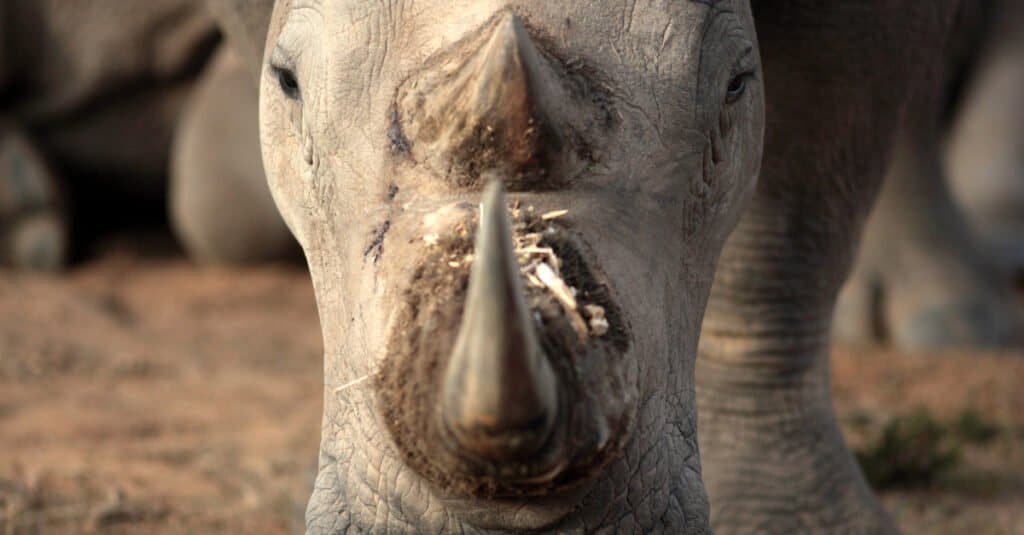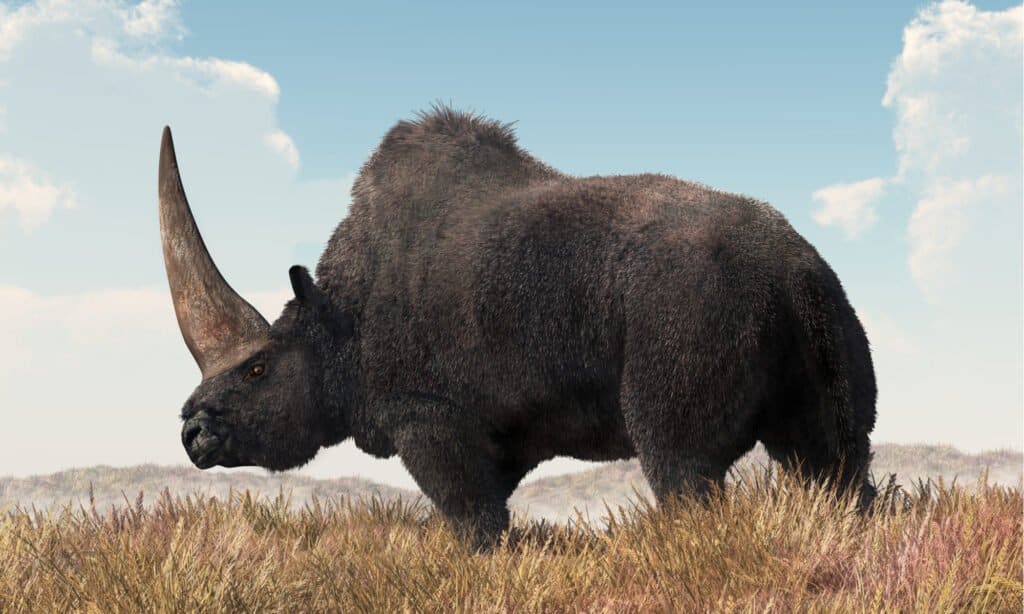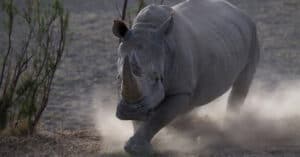Think about something that is about 4-5 feet tall. Maybe that is how tall you are? Did you know that one rhino horn can get to be 4 ½ feet long! Most are closer to 1 ½ feet, but even that is impressive! All of the five rhino species have horns on both the males and females.
But, what are rhinos horns made of?
Three of the species have two horns (the white rhino, black rhino and Sumatran rhino) and two of the species only have one horn (the Javan rhino and Indian rhino which is also, understandably, called the Greater one-horned rhino).
So, what are these giant horns made of? What other animals have horns? What is the difference between horns, antlers and tusks?
What rhino species has the biggest horns? Let’s find out!
What is the Difference Between Horns, Antlers, and Tusks?

Rhino horns are made of keratin which is the same protein as fingernails.
©JONATHAN PLEDGER/Shutterstock.com
- Cows, goats and sheep all have horns.
- Elephants, walruses, and warthogs have tusks.
- Moose, caribou and deer have antlers.
So, what is the difference between all these head protrusions! What are rhinos horns made of and are they permanent?
Horns are permanent (they are not shed), are typically found on males and females, and have a boney core with a coating of keratin. Because they grow from the skin at the base they can regrow if an animal loses one. The rhino’s horn is a bit different, we will get to that!
Tusks are made of ivory and are actually teeth that continue to grow longer. An elephant’s tusk can grow to be 6 feet long! But if an elephant loses a tusk it will not grow back. Other animals that you might not think of having ivory tusks are the bottom incisors of hippos and the unicorn-like spear of a narwhal!
Antlers can be seen on caribou and deer as well as the huge rack of a moose. Antlers are not permanent and are shed every season. They quickly regrow in time for the following mating season. Antlers are made from bone and grow from the tip vs the base. As antlers are growing you can see that they look furry, this covering is called velvet and it holds blood vessels and nerves. Deer will shed their velvet by rubbing their antlers on trees when their antlers are fully formed.
What are Rhinos Horns Made Of?

Both male and female rhinos have horns.
©Maggy Meyer/Shutterstock.com
What are rhinos horns made of? Rhinos do have horns, not antlers or tusks. But their horns are not boney on the inside, the entire horn is made of tightly woven keratin (the same protein our fingernails and hair are made of). Both male and female rhinos have horns and they are permanent. If a rhino loses a horn they will grow back which usually takes around 3 years.
How Long is the Longest Rhino Horn on Record?
According to the International Rhino Foundation, the longest rhino horn recorded was 59 inches long (an inch short of 5 feet)! This was from a white rhino in South Africa. It was reported stolen from its owner Sir William Gordons Cummings and has yet to be found. In Kenya, there was a black rhino horn that was 51 inches and at the British Museum you can see two record-breaking rhino horns, one from a Greater one-horned rhino (23 inches) and one from a Sumatran rhino (also 23 inches).
What was the longest ancient rhino horn?

Elasmotherium
had a horn that measured 3 feet in circumference!
©Daniel Eskridge/Shutterstock.com
The ancient rhino with the largest horn was likely Elasmotherium. These giants live across the Eurasian Steppe where nations like Ukraine, Russia, and Kazakhstan are today. They had a horn that was significantly larger at its base than today’s rhinos. It had an incredible circumference of three feet! Elasmotherium went extinct about 39,000 years ago along.
Why are Rhino Horns so Valuable and Why are Rhinos Being Poached for Them?
For centuries rhino horns have been coveted and used in traditional Chinese medicines, ground up and mixed with boiling water and is thought to cure fevers, arthritis and gout. Some even believe it contains cancer-curing properties others think it an aphrodisiac. There is no medical proof that rhino horn has any medicinal elements. The horns are also used for carvings for art and jewelry.
It is illegal to hunt rhino and to trade their horns, but the black market is still very active. This is why the number of rhinos over the years has been drastically reduced leaving some of the species “Critically Endangered” by the IUCN. At the Hanoi airport in Vietnam, a shipment of rhino horns was confiscated and the 125kg of horns was valued at $7.5 Million dollars!
That is what conservationists are up against, but sieges like these are working to send a clear message to those who still try to poach endangered rhinos.
The photo featured at the top of this post is © topimages/Shutterstock.com
Thank you for reading! Have some feedback for us? Contact the AZ Animals editorial team.






